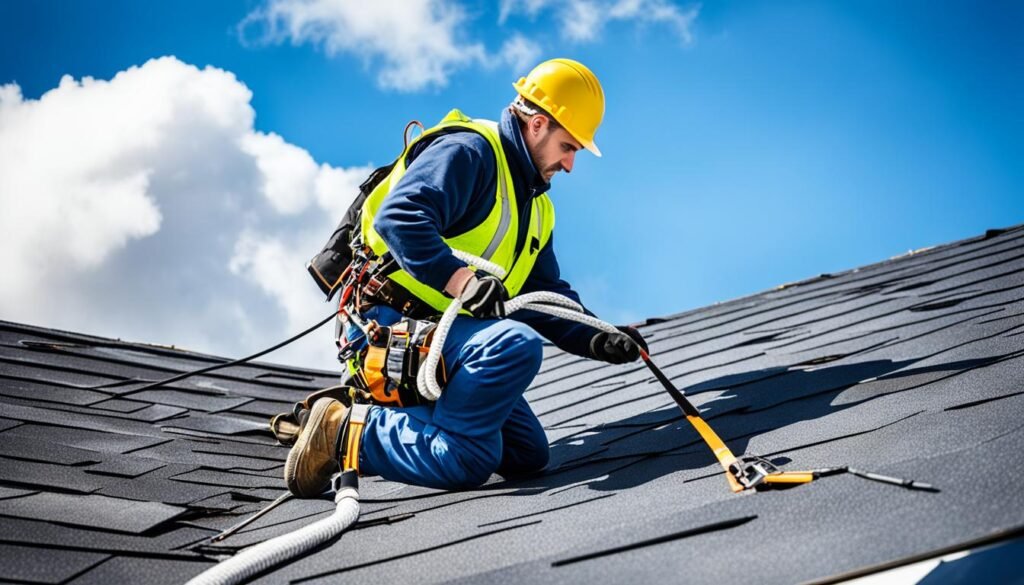Falls are the top cause of death in roofing, making up 34% of all fall deaths in construction. This fact highlights how critical roof safety is. As a roofing contractor, keeping your team safe comes first. You must follow OSHA rules to prevent workplace accidents and deaths.
This guide will dive into important strategies and tools for a safe roofing work site. We will look at OSHA standards and the right personal protective equipment (PPE). Knowing these things will help you lower the risks of roofing and promote safety in your team.
Key Takeaways
- OSHA regulations require fall protection equipment for any work over 6 feet above a lower level
- Roofers must wear safety harnesses when working on surfaces more than 6 feet above a lower level
- Comprehensive worker training on safety protocols is essential for accident prevention
- Proactive measures like roof inspections can identify hazards before work begins
- Establishing a safety-first culture within the roofing industry is crucial for the well-being of all stakeholders
Understanding Rooftop Hazards
Working on roofs means facing many dangers, but falls are most risky and can be deadly. It’s key to spot and lessen fall dangers to keep workers safe up high.
Fall Hazards
Places on the roof like skylights and open areas are big fall risks. When not shielded, the edges of roofs can cause severe falls. Things also might drop and hurt others below. Installing guardrails, barriers, and skylight covers is vital for safety.
According to OSHA’s rule 1910.28, all roof holes must have shields on every open side. Wear a fall harness and get proper training for rooftop work. This helps keep everyone working up high without danger.
Power Tool Dangers
Using power tools and dealing with electric dangers and bad materials on the roof is risky. Knowing how to use tools safely, handle electrical dangers, manage bad materials, and work in tough weather is important. Learning these skills can reduce accidents.
Check safety gear on the roof often, like ladders, to make sure they’re safe. Proper training teaches workers to see and deal with dangers. This knowledge makes the roof a safer place to work.
| Rooftop Hazard | Key Mitigation Strategies |
|---|---|
| Fall Hazards |
|
| Power Tool Dangers |
|

To keep workers safe on roofs, be proactive. Do safety checks, offer detailed training, and always follow the rules. These steps are crucial for a safe and successful roof job.
Roof Safety Practices
It’s crucial to have strong roof safety measures. They keep workers safe and make roofing projects successful. This includes steps like talking before you start, watching the weather, ladder safety, wearing the right gear, keeping roofs clean, using guardrails, protecting skylights, and maintaining proper rooftop signs.
Start work by having pre-start talks. Identify risks and set safety rules. Avoid poor weather conditions like rain, snow, or strong winds to cut down on dangers.
Taking care with ladder safety is vital too. Place ladders on flat ground, tie them down to stop slips, and make sure they’re three rungs above gutters. This makes getting down safely easier. Proper PPE, including sturdy shoes and harnesses, is key for reducing fall risks.
- Roofers need shoes with strong grips to prevent falls.
- Safety harnesses offer big protection, linking to steady parts of the roof.
- Ensure ladders sit on stable ground and are tall enough for easy descent.
Clearing the roof of debris, such as nails or tools, is essential for avoiding injuries. Adding guardrails and covering skylights with protection helps too. Extra care is needed with slate and tile roofs to protect them and the workers.
Having clear safety signage on site helps a lot. It warns about dangers and directs workers. Following these steps builds a safety-focused work environment and lowers risks.
“Falls account for three-fourths of all fatalities in the roofing industry.”
By focusing on these roof safety tips, you safeguard your crew, dodge accidents, and complete your projects successfully.

Conclusion
Keeping the roof safe is crucial for any roofing job. It protects the workers and helps the job go smoothly. Local Roofer Pros and other roofers in Murrieta, CA focus on knowing the dangers, adding safety steps, and valuing a safe workplace culture.
Working with OSHA rules and the right gear keeps safety top-notch. This approach covers roof safety, fall protection, and OSHA compliance. It means not just looking out for your team, but also improving how well and safely the work gets done.
To keep the work area safe and ready for success, keeping up with roof safety rules is a must. Regular checks and trainings for team members are key. By showing they care about roof safety, Local Roofer Pros and others in Murrieta prove they value their workers and the local community.
FAQ
What are the key strategies for maintaining roof safety?
What are the common rooftop hazards that need to be addressed?
What are the essential roof safety practices that should be followed?
How can roofing contractors in Murrieta, CA, prioritize roof safety?
Source Links
- https://trdsf.com/blogs/news/roof-safety-tips
- https://safetyculture.com/topics/roof-safety/
- https://www.dumpsters.com/blog/roofing-safety-tips
- https://simplifiedsafety.com/blog/top-10-rooftop-safety-hazards/
- https://www.safetyandhealthmagazine.com/articles/24821-rooftop-hazards
- https://kattsafe.com/resources/blog/common-roof-hazards
- https://www.prestigeroofinglv.com/understanding-roofer-safety/
- https://simplifiedsafety.com/blog/6-best-practices-for-corporate-roof-safety/
- https://www.edisonenergy.com/blog/on-the-job-safety-with-ee-roof-safety-tips/
- https://www.gsmroofing.com/news/mastering-the-heights-the-ultimate-safety-guide-for-your-commercial-buildings-roof/
- https://www.buildings.com/industry-news/article/10187943/best-practices-for-roof-safety
- https://safetyrailcompany.com/blog/roof-safety-equipment-what-you-need-to-know-to-keep-your-workers-safe/
- Local Roofer Pro
